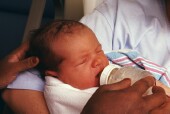
FRIDAY, July 6 (HealthDay News) — When Hacah Boros gave birth to her daughter three years ago, giving her infant formula was “completely out of the question,” said the 35-year-old nurse from central Connecticut.
She was worried about bisphenol A (BPA), a common chemical in plastics and also a “hormone disruptor” associated with changes in child growth and development.
“I was aware that BPA was a problem and fortunately able to breast-feed,” Boros said. Since then, Connecticut became the first state to ban BPA from infant-formula and baby-food containers, a law that went into effect in October 2011.
Boros said she might not completely avoid formula for her second child, due in August.
“If I need to resort to it, it’s an actual option and I don’t feel like I’m poisoning my child this time,” said Boros, who is a volunteer for the Coalition for a Safe & Healthy Connecticut, which helped support the law.
BPA often is added to the material that lines food cans to increase shelf life and prevent rusting, and it can get transferred to the food inside the container.
Many of the major makers of infant formula, including Similac, Gerber and Enfamil, have voluntarily stopped using BPA in the past several years in response to consumer preference and state legislation in Connecticut and Vermont.
Even so, formula makers including Abbott (Enfamil) do not label their products as BPA-free.
“In the absence of legislation and mandated labeling, it is hard for consumers to determine which products are actually BPA-free,” said Dr. Maida Galvez, an associate professor of pediatrics and preventive medicine at the Mount Sinai School of Medicine in New York City.
The U.S. Food and Drug Administration is currently reviewing a petition that was submitted in March to reverse its approval of BPA in formula containers.
Ideally, Galvez said, there would be a system in which an independent party certifies the product to make sure it is BPA-free.
But if the FDA prohibits BPA, it could lead to problems if the packaging that replaces BPA-containing material is not stable or leads to health concerns, said Robert Rankin, associate director of the International Formula Council, a trade association that represents makers and marketers of infant formulas.
“If BPA is not there as a backup plan, you have a potential gap in the supply chain,” he said.
Whereas there are decades of safety data for BPA, there may be less known about the packaging material that replaces BPA, Rankin said.
Although the FDA is continuing to review the safety of BPA, a March 30 agency statement said there currently is not sufficient scientific evidence that the low levels found in foods are unsafe. The American Medical Association supports the development of BPA alternatives in infant-formula containers.
“We just try to focus on prevention,” said Dr. Sheela Sathyanarayana, assistant professor of pediatrics at the University of Washington in Seattle. “There really are no safe limits. Lower doses can lead to health effects.”
Exposure to BPA during pregnancy and in newborn babies has been associated with hyperactivity and aggressive behavior in children at 2 years of age.
The major baby-bottle manufacturers announced in January 2009 that they had eliminated the use of BPA, making the widespread move before makers of infant formulas. Children’s toys generally are not made out of plastics that contain BPA.
Parents can take many steps to further reduce or avoid BPA exposure when feeding their baby:
- Call the maker of your baby formula, Galvez said. Ask whether they use BPA materials if you can’t find a BPA-free label, and whether they test the product for BPA before shipping.
- If it is not clear that the formula is BPA-free, look for it in glass or plastic instead of metal cans. The types of plastic used to package formula do not typically contain BPA.
- If a powder formula is available that offers good nutritional benefits for your infant, choose powder over liquid. Powders typically have lower levels of BPA.
- Avoid introducing BPA in powder formula during preparation by mixing the powder in a BPA-free bottle or container.
- Look for the recycling code on plastic containers and avoid code 7, which means the plastic can contain BPA.
- Dissolve powder in warm but not boiling water. BPA leaches from containers more at high temperatures.
- Support the Safe Chemicals Act, which would require safety data for chemicals before they enter the market or that are already on the market. “Supporting that kind of legislation is what will truly reduce exposure to the entire population,” Sathyanarayana said.
Studies also have detected BPA in breast milk, and there are some indications that the level can be higher than in infant formula.
Even if this is the case, “the benefits of breast milk likely far outweigh the concerns of BPA,” Galvez said.
Another tip to reduce BPA exposure is to wash your hands well after handling store receipts because they contain high levels of BPA, Sathyanarayana said.
More information
The U.S. Department of Health and Human Services has more about BPA.

